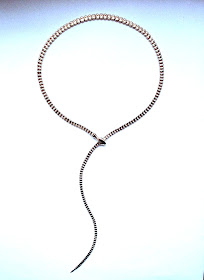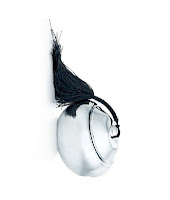Dec 30, 2011
Dec 22, 2011
Dec 1, 2011
A TAIL TALE
the snake necklace
in sterling silver and 18k yellow gold
(designed 1974)
...The idea for this necklace came from the endpiece of a rattlesnake tail, given to Elsa Peretti by a Texan as a good luck charm. A venomous serpent native to the Americas, the rattlesnake has a long history in folklore. "I thought Americans had to be brave, having these kinds of snakes in their backyards... i kept the object with me for many years. The expertise of excellent craftsmen and my will brought the snake to life in silver and gold." (Elsa Peretti, 1990)
Information from Robert Corio of Designs International on the manufacture of the snake necklace:
'The links are bean-shaped and come in several sizes to accommodate the taper in each snake. Originally the necklace took 70 man hours to assemble these tiny beans. After the beans are cast, using a sprue long enough to help with handling, the beans are finished outside. To deal with the pitting, a specially-made curved hammer is used to mend the imperfections from the casing process. The two constants are shape and weight, i.e. the craftsmen have to ensure that the bean does not lose its shape in the hammering and that it doesn't lose too much weight as there is inevitably some casting surface that is removed. After hammering they need very little polishing.
Assembly is begun in the middle, working outward to the tail in one direction and to the head in the other, attaching one link in each direction alternately, ending with the 28" length. The craftsman who assembles the necklace follows an enlarged chart referencing number and size of the 191 moving parts. Each link is then secured to the next link and care must be taken to avoid fusing the links together and thus losing the movement of the links. Each link is then hammered to burnish over metal to provide a clean surface that won't show any evidence of assembly and to ensure the look and feel that Elsa Peretti demands. The head is made complete before attaching and is tested repeatedly while adjustments are made until it works properly. The underside of the head has a safety catch also in the form of a snake head and stops the catch from slipping. While attaching the head and tail the body is covered with a protective paper so that no repolishing is needed, as every piece is delivered with a mirror like finish and flawless to the eye. The snake is constantly limbered during the process to make sure it is flexible throughout and to retain its fluid movement.
It takes 8 different specialists to make the snake, there are 18 operations for the entire piece, and weighs approximately 4 ounces of 18 carat gold."
©Elsa Peretti® Tiffany&Co.
Nov 6, 2011
Oct 28, 2011
Sep 19, 2011
Sep 7, 2011
Jul 28, 2011
DAYS OF GOLD
it's vacations time... make your days of gold
♡
bracelet in 18k gold with starfish charm in 18k gold
©Elsa Peretti® Tiffany&Co.
©Elsa Peretti® Tiffany&Co.
Jul 14, 2011
THE MESH GENESIS
..."At the beginning of her jewellery career Elsa Peretti became fascinated by mesh she saw being handmade in India. Seeking technical expertise, she contacted New York's Fashion Institute of Technology, which led her to Prof. Samuel Beizer (1931-2000), first director of the jewellery department at FIT, who became a friend and collaborator. He sought out Whiting and Davis, a Massachusetts based company that was known for making mesh of all kinds.
In particular, they were recognized for their pressure metal mesh which was used to make decorated and jewelled evening bags in the early part of the 20th century. Elsa Peretti has always admired them but had been told they had once all been made by hand and it could not be done any more. Intrigued by their intricacy and suppleness, Beizer began to collect them to work out how it was done. He contacted Whiting and Davis, and in about 1974 he and Elsa together were able to rescue some of the old machines, finding an 80-year old former employee who had worked on the machines when he was young. Beizer obtained some sample mesh from Whiting & Davis which he made into earrings, and this gave Elsa an entirely new medium for jewellery and one that has been exclusively hers to this day. The old machines were restored and produce the gold mesh for Elsa Peretti today.
The mesh is machine-knitted like a stocking, to avoid seams, with solder-filled wire, then heated until the solder flows closing each link. It is then cut to shape by hand and turned into jewellery by Samuel Beizer Associates. A mesh scarf contains about 43,000 links.
The collaboration with Beizer was commemorated in 2001 with the creation of the Elsa Peretti Professorship in Jewelry at the F.I.T., endowed in recognition of Peretti's twenty-fifth anniversary with Tiffany & Co. and at her request, in memory of Samuel Beizer, whom she had assisted in developing the curriculum.
The scarf necklace was the end result, but Elsa Peretti's first creation in mesh was a gold bra or halter top (photo). As Peretti herself puts it: 'Inspired by the beautiful atmosphere in Jaipur, I thought about a gold bra; the object was then painstakingly executed there.
Back in New York, the idea progressed with the great help and generosity of Sam Beizer, teacher at F.I.T. The object was shown in a Halston collection; Tiffany was swamped with calls from people dying to get a gold bra.' ('Fifteen of my Fifty with Tiffany & Co', exhibition catalogue, F.I.T, New York 1990). For a silver mesh halter top see 'Bejewelled by Tiffany 1837-1987', exhibition catalogue, The Gilbert Collection, C. Phillips Ed., London 2006, no. 169"....
mesh scarf necklace in 18k yellow gold
mesh halter top in 18k yellow gold
mesh scarf earrings in 18k yellow gold
mesh scarf earrings in 18k yellow gold
mesh necklace with diamonds in 18k yellow gold
mesh bracelet in 18k yellow gold
©Elsa Peretti® Tiffany&Co.
Jun 28, 2011
Jun 20, 2011
A FAITHFUL HEART
Open heart pendant
(designed 1974)
©Elsa Peretti® Tiffany&Co.
The open heart pendant is made in silver and gold, in three sizes. It can also be worn with a gold or silver chain instead of the silk cord (see 'Bejewelled by Tiffany', exhibition catalogue, C. Phillips ed., London 2006, no. 172). It has become Peretti's most popular item, for which she has also designed matching earrings and ring. It is this piece, along with her silver bean, also made in different sizes, that enabled her to revolutionise the popularity of silver jewellery.
In 1990, Elsa Peretti explained the genesis of the heart pendant: 'I really think that the idea for the best-selling item of my collection sprang from a void in a Moore sculpture, a big one. No one else saw a heart there. Just me. The shape was there, in metal. What I couldn't work out was how to hang it from the chain. Mr. Kalich, then head of Tiffany jewellery, suggested with his strong German accent: "Why dont we put it through". I was so overjoyed that I gave my first model to his fiancée.' The heart was featured on the cover of 'Newsweek' April 1977, with a cover story entitled 'Jewelry's New Dazzle', which reported that 'What Peretti had was a whole new idea of what jewelry should be: more design than decoration.......real jewelry has become accessible and affordable for every shopgirl.' (quoted in J. Loring, 'Tiffany Jewels', New York 1999, p. 215).

















































